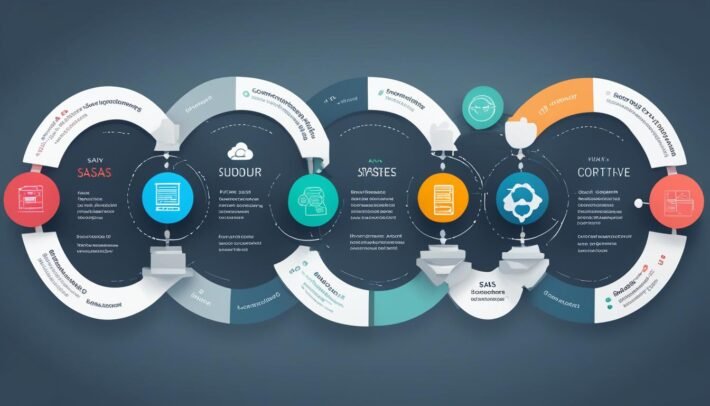Mastering User Onboarding for SAAS Success

Creating an exceptional user experience is key to the success of Software as a Service (SAAS) products. Effective user onboarding techniques are critical to achieving this goal. User onboarding sets the tone for the entire SAAS user experience, impacting user retention and loyalty. Strong onboarding techniques help new users understand the product, gain value from it, and remain engaged.
This article covers key onboarding techniques and best practices that can help you master user onboarding for SAAS success. We will explore the various elements of successful user onboarding, the importance of personalization, engagement strategies, measurement, and improvement approaches, and more.
Key Takeaways
- Successful user onboarding is critical to SAAS success
- Effective onboarding techniques help users understand the product and remain engaged
- Clear communication, intuitive design, and seamless interactions are essential for successful onboarding
- Personalizing the onboarding experience improves user engagement and retention
- Continuous improvement through feedback, testing, and iteration is vital for achieving exceptional onboarding experiences
Understanding User Onboarding
User onboarding is the process of introducing new users to a product or service and guiding them to become active and successful users. In SAAS, user onboarding is a critical factor that shapes the overall user experience. It helps users understand how the product/service works and how it can solve their pain points. Effective onboarding techniques can significantly increase user retention and loyalty.
The main goals of user onboarding are to:
- Introduce users to the product/service
- Guide users to understand how the product/service works
- Explain the benefits of using the product/service
- Ensure users accomplish their desired outcomes
The impact of user onboarding on SAAS user experience can be profound. A well-designed onboarding process enables users to quickly and efficiently achieve a desired outcome. It can help ease user anxiety and frustration by providing clear and concise instructions and minimizing confusion.
For example, when a user signs up for a new SAAS product and is presented with a confusing interface, they may become frustrated and abandon the product. However, if the product’s onboarding process is intuitive and guides the user through each step, the user will feel confident and more likely to continue using the product.
| Goal | Metric |
|---|---|
| Engage the user | Time spent on task or in-app |
| Help the user achieve a desired outcome | Task completion rate |
| Reduce user churn | User retention |
| Improve user satisfaction | User feedback score |
Key Takeaway
User onboarding is essential to creating an exceptional SAAS user experience. Its goals are to introduce users to the product/service, guide them through the functionality, and ensure that they accomplish their desired outcome. Through effective onboarding techniques, users gain confidence and trust in the product, leading to increased user retention and loyalty.
Key Elements of Successful User Onboarding
In order to create an effective onboarding experience for users, it is essential to focus on a few key elements. Clear communication and intuitive design are two critical components that allow users to easily navigate the onboarding process. Giving users clear instructions and explanations throughout the process can help to avoid confusion and frustration.
Visual cues, such as progress indicators and highlighted features, can also help users to understand their progress and what is expected of them. Furthermore, offering seamless interactions through intuitive design can provide users with a feeling of ease and confidence during the onboarding process.
Interactive guides, such as tutorials or walkthroughs, can also assist users in understanding how to use the software or service. By offering real-world examples, providing useful tips, and demonstrating key features, users can become more familiar and comfortable with what the software or service can do for them.
By combining clear communication, intuitive design, and seamless interactions, developers can create an effective onboarding experience that sets users up for success. Whether it is a mobile app or a web-based tool, these key elements can help users get started faster and feel confident in their ability to use the software or service.

Designing an Intuitive Onboarding Flow
Designing an intuitive onboarding flow is critical to ensure users navigate the product or service easily while experiencing a smooth onboarding process. Simplifying complex processes, providing visual cues, and offering interactive guides are important onboarding techniques that designers can use while creating the onboarding flow.
When designing an onboarding flow, it is essential to focus on the user experience. The onboarding flow should be easy to follow, with clear instructions and intuitive design. Providing visual cues in the form of arrows, animations, or icons can help guide the user throughout the process. Interactive guides, like chatbots or walkthroughs, can provide users with an interactive experience, making the onboarding process more interesting and engaging.
Creating a Simplified Onboarding Process
Users may feel overwhelmed when they’re presented with multiple options or complex processes. To avoid this, designing an onboarding flow with a simplified process is essential. This simplification can involve breaking down larger processes into smaller steps. Each step should have its goal and instructions.
Designers must keep in mind that each step is equally important, but the onboarding process should not be too long. A prolonged onboarding can reduce interest in the product or service. Balancing the flow’s length with the amount of information shared can keep users intrigued throughout the process.
Providing Clarity Through Visual Cues
The use of visual cues can make the onboarding process more comfortable for users to follow. Colors, shadows, and contrast can emphasize essential elements of the flow, like the next step. Arrows and animations can lead the user, and icons highlight relevant sections.
| Element | Description |
|---|---|
| Color | Using color to highlight essential design elements can create emphasis, readability, and mood. |
| Icons | Icons are graphical representations of information that users can easily identify with and navigate through. |
| Animations | Animations can add flair and visual interest to the onboarding process, making it more engaging while guiding the user. |
| Arrows | Arrows can provide the user with a direction to follow, pointing out essential elements, buttons, or icons within the flow. |
Interactive Guides for Enhanced Experience
Interactive guides can provide users with an immersive onboarding experience. Chatbots or walkthroughs chatbot can offer product information, usage scenarios, and tips while answering queries, making the onboarding process much more engaging.
Designers need to focus on creating an immersive environment. It involves understanding user expectations and providing them with an interactive experience that they would find exciting and enlightening,enhancing their experience and piquing their interest in the product or service.
Creating Engaging Onboarding Content
Creating engaging onboarding content is critical to keeping users interested and invested in your product or service. Whether through compelling visuals, informative tutorials, or interactive elements, successful onboarding begins with capturing and maintaining your user’s attention.
One effective way to create engaging content is by providing interactive tutorials that guide users through the onboarding process. By using simulations and hands-on experiences, users can learn about your product or service in a way that is immersive and memorable.
Another way to engage users is through the use of compelling visuals, such as infographics or videos. Visuals can help to communicate complex information quickly and effectively, reducing the learning curve for users and increasing their understanding of your product or service.
When creating your onboarding content, it is also essential to keep your user’s needs and interests in mind. By leveraging user data and insights, you can personalize your onboarding content to deliver a more tailored experience that resonates with your users and increases their engagement.
“Design is not just what it looks like and feels like. Design is how it works.” – Steve Jobs

Ultimately, creating engaging onboarding content is about providing a seamless and enjoyable experience that guides users through the onboarding process and sets them up for success. By following these onboarding techniques, you can create a product or service that meets the needs of your users and increases retention rates.
Personalizing the Onboarding Experience
One of the essential elements of successful user onboarding is personalization. Personalized onboarding experiences cater to individual user needs, creating a sense of ownership and loyalty to the product or service. By harnessing user data, companies can deliver targeted onboarding content that resonates with users, improving engagement and retention rates.
Segmentation is a critical aspect of personalization in user onboarding. By dividing users into distinct groups based on shared attributes or behaviors, companies can design tailored onboarding experiences that address specific pain points and needs.
| User Segments | Description | Onboarding Techniques |
|---|---|---|
| New Users | Users who have never used the product or service before | Interactive product tours, informative tutorials, introductory videos |
| Power Users | Users who frequently use the product or service and have advanced skills | Advanced tutorials, feature-specific demos, personalized recommendations |
| Struggling Users | Users who are having difficulty navigating the product or service | Contextual help, in-app messaging, live chat support |
Personalizing the onboarding experience extends beyond just content delivery. It also includes customizing the onboarding path and pace based on user preferences. For instance, some users may prefer a self-guided onboarding approach, while others may prefer more hands-on assistance. By providing flexible options, companies can optimize the onboarding experience and ensure user satisfaction.
By personalizing the onboarding experience, companies can foster a deeper connection with users, increasing their investment in the product or service. As a result, they are more likely to become loyal customers, contributing to the long-term success of the company.
Implementing Proactive User Support
Proactive user support is an essential aspect of effective user onboarding. By anticipating user concerns and questions, companies can minimize user frustration and ensure a smooth onboarding experience. In-app messaging, live chat, and customer support channels are effective tools for providing immediate assistance to users during the onboarding process.
Live chat provides users with instant access to customer support representatives who can provide real-time assistance. Companies can also use chatbots to automate common queries and provide users with 24/7 support.
In-app messaging is another way to provide proactive user support. By sending targeted messages to users at specific points in the onboarding flow, such as when they complete a key task or encounter an error message, companies can guide users through the process and address any concerns they may have.
Customer support channels, such as phone and email, are also effective tools for providing proactive user support. By providing users with multiple channels for assistance, companies can accommodate different user preferences and ensure that all users receive timely and effective support.

In summary, implementing proactive user support is essential to ensuring a successful onboarding experience. By using in-app messaging, live chat, and customer support channels, companies can provide users with the immediate assistance they need to navigate the onboarding process effectively.
Measuring Onboarding Success
Measuring onboarding success is crucial to evaluate the effectiveness of onboarding techniques and make necessary adjustments. Key metrics and analytics tools can be used to track user engagement, retention, and conversion rates.
User Engagement Metrics
User engagement metrics reflect how users interact with the onboarding process. They can include the number of users who complete onboarding, the average time it takes to complete onboarding, and the percentage of users who drop off during the process.
User Retention Metrics
User retention metrics measure how many users continue to use the product or service after completing onboarding. They can include the number of users who remain active after a specific period and the percentage of users who return to the product or service in a given time frame.
Conversion Metrics
Conversion metrics track the number of users who complete specific actions, such as upgrading their subscription or making a purchase. They can indicate the effectiveness of onboarding in driving conversions and revenue growth.
Analytics tools such as Google Analytics, Mixpanel, and Kissmetrics can help track these metrics and provide valuable insights into onboarding performance. It’s essential to regularly review these metrics to identify areas for improvement and optimize the onboarding experience for better user retention and satisfaction.
Optimizing Onboarding for Mobile Users
In today’s era, mobile devices have become the medium of choice for accessing and interacting with SAAS applications. Therefore, optimizing user onboarding for mobile users is crucial to providing a seamless and enjoyable user experience that encourages users to continue using the app.
Using responsive design is one of the most crucial elements of mobile optimization, ensuring the onboarding process remains visually engaging, regardless of the screen size. Additionally, simplifying the interfaces and converting any multi-step processes into a single, straightforward interaction makes it easier for users to navigate through the onboarding process.
Mobile-specific onboarding techniques, such as short, bite-size tutorials, and interactive elements that leverage mobile device capabilities (e.g., swipe, pinch, and tap) are also critical factors in providing a positive onboarding experience on mobile. Finally, monitoring users’ interactions while onboarding through analytics helps to identify pain points and areas for improvement.
Benefits of Optimizing Onboarding for Mobile Users:
- Increased engagement: By providing a seamless onboarding experience, mobile users are more likely to continue using the app, leading to better engagement and retention rates.
- Improved user experience: Mobile optimization is essential for providing an intuitive and enjoyable onboarding experience that encourages continued use of the app.
- Higher conversion rates: By creating a positive onboarding experience, mobile users are more likely to become paying customers, leading to higher conversion rates and increased revenue.
By optimizing onboarding for mobile users, it is possible to create a positive user experience that enhances engagement, retention, and revenue, making it an essential element of any SAAS application’s success.
Continuous Onboarding Improvement
Effective user onboarding does not end once users complete the initial setup. It is an ongoing process that requires continuous improvement to ensure a positive SAAS user experience. Companies should understand the importance of collecting user feedback, conducting usability testing, and iterating on their onboarding process based on user insights.
By collecting user feedback, companies can gain valuable insights into what users want and need out of their SAAS experience. This feedback can help companies identify pain points in the onboarding process and make necessary adjustments to improve overall user satisfaction.
Usability testing can also be a highly effective tool for improving the onboarding process. By observing users as they go through the onboarding experience, companies can identify areas where users are experiencing difficulties and make targeted adjustments to address these issues.
Key Takeaways:
- Continuous improvement is necessary for successful onboarding
- User feedback is crucial for identifying pain points in the onboarding process
- Usability testing can help pinpoint areas of difficulty for users
- Iterating on the onboarding process based on user insights leads to higher user satisfaction
“The most effective onboarding experiences are those that are continuously evaluated, improved, and personalized based on user feedback and insights.”
Onboarding Best Practices and Case Studies
This section provides insights into the most successful onboarding techniques and offers real-life case studies for inspiration and guidance.
Best Practices
Effective user onboarding begins with understanding the user’s needs and expectations. With this in mind, here are some best practices for a successful onboarding experience:
- Keep it simple: Avoid overwhelming users with too much information at once. Provide a clear and concise onboarding flow that minimizes confusion and encourages engagement.
- Provide interactive guidance: Use visual cues, interactive tutorials, and tooltips to keep users engaged and reinforce their understanding of the product or service.
- Personalize the experience: Use segmentation and user data to deliver targeted onboarding content that speaks directly to the user’s needs and interests.
- Establish clear expectations: Communicate what users can expect from the onboarding process and set realistic goals and objectives to help them feel empowered and motivated.
Case Studies
Here are some examples of companies that have achieved exceptional onboarding experiences:
| Company | Description | Onboarding Techniques |
|---|---|---|
| Slack | A popular messaging and collaboration platform. | Targeted messaging, personalized welcome messages, interactive tutorials, and tooltips. |
| Spotify | A music streaming service with millions of tracks. | Personalized recommendations, guided playlists, and interactive onboarding. |
| Shopify | An e-commerce platform that helps businesses sell their products online. | Simplified sign-up process, personalized dashboard, and interactive onboarding tutorials. |
Learning from successful case studies can help you develop an onboarding experience that resonates with your users and increases retention.
The Future of User Onboarding
The evolution of technology is driving changes in the user onboarding landscape. With the potential of AI, machine learning, and personalization technologies, the future of onboarding holds immense promise.
AI and Machine Learning: These technologies can help streamline the onboarding process by automating tasks, such as data collection and analysis. Advanced algorithms can also offer tailored recommendations and personalized experiences based on user behavior, preferences, and needs.
Personalization: According to Salesforce’s State of the Connected Customer report, 73% of customers expect companies to understand their needs and expectations. As such, companies need to deliver more personalized onboarding experiences, accounting for language, location, and other individual factors.
Challenges Ahead
As with any new technology, implementing AI, machine learning, and personalization comes with its set of challenges.
Data Privacy and Security: As companies collect and use more customer data, they must ensure that user privacy and security are protected from threats such as data breaches and hacks.
Accessibility: Not all users have equal access to technology, and some may face challenges with cognitive, visual, or hearing impairments. Companies need to ensure that everyone can benefit from onboarding technologies.
Conclusion
In conclusion, mastering user onboarding techniques is essential for SAAS success. Creating an exceptional user experience through effective onboarding techniques is critical in increasing user retention and loyalty. By understanding the goals and objectives of user onboarding, companies can create a seamless and intuitive onboarding flow with clear communication and interactive guides.
Engaging onboarding content and personalization based on user data and segmentation can help improve user engagement and satisfaction. Implementing proactive user support through in-app messaging, live chat, and customer support channels can address user questions and concerns during the onboarding process.
Measuring onboarding success through key metrics and analytics tools can help evaluate the effectiveness of onboarding techniques, and continuous onboarding improvement based on user feedback and usability testing can ensure a constantly evolving user experience.
By optimizing onboarding for mobile users and adapting to emerging trends and technologies in the future of user onboarding, companies can stay ahead of the competition and deliver exceptional SAAS user experiences. In conclusion, exceptional user onboarding techniques are essential for driving user retention and loyalty, and companies must prioritize and invest in creating an outstanding onboarding experience for their users.
FAQ
What is user onboarding?
User onboarding refers to the process of guiding and familiarizing new users with a software or service. It aims to provide a seamless and positive experience, ensuring users understand how to use the product and maximize its value.
Why is user onboarding important for SAAS success?
User onboarding plays a crucial role in SAAS success as it helps increase user retention and engagement. By providing a smooth and effective onboarding experience, SAAS companies can drive customer satisfaction, reduce churn rates, and foster long-term user loyalty.
What are the key elements of successful user onboarding?
Successful user onboarding requires clear communication, intuitive design, and seamless interactions. It involves setting clear expectations, providing step-by-step guidance, and offering help when needed to ensure users can easily navigate the onboarding process.
How can I design an intuitive onboarding flow?
Designing an intuitive onboarding flow involves simplifying complex processes, using visual cues to guide users, and providing interactive guides or tooltips. It’s important to make the onboarding process streamlined, efficient, and user-friendly.
Why is creating engaging onboarding content important?
Engaging onboarding content captivates users and keeps them interested throughout the onboarding process. By using compelling visuals, informative tutorials, and interactive elements, companies can enhance the onboarding experience and increase user engagement.
How can I personalize the onboarding experience?
Personalizing the onboarding experience involves leveraging user data and segmentation to deliver targeted onboarding content. By tailoring the onboarding process to individual users’ needs and preferences, companies can increase user engagement and satisfaction.
What role does proactive user support play in onboarding?
Proactive user support is vital in addressing user questions and concerns during the onboarding process. In-app messaging, live chat, and customer support channels can help users resolve issues quickly, improving their overall onboarding experience.
How can I measure onboarding success?
Measuring onboarding success involves tracking key metrics such as user engagement, retention rates, and conversion rates. Analytics tools can provide valuable insights into user behavior, helping companies assess the effectiveness of their onboarding techniques.
Why is optimizing onboarding for mobile users important?
Optimizing onboarding for mobile users is crucial as more people access SAAS products and services through mobile devices. By employing responsive design, simplified interfaces, and mobile-specific onboarding techniques, companies can ensure a seamless onboarding experience across different devices.
How can I continuously improve user onboarding?
Continuous improvement in user onboarding can be achieved through collecting user feedback, conducting usability testing, and iterating on the onboarding process based on user insights. This iterative process helps refine the onboarding experience and address any pain points or areas for improvement.
Are there any best practices or case studies for user onboarding?
Yes, best practices and case studies exist for user onboarding. These provide insights and examples of companies that have successfully implemented effective onboarding techniques. Studying these real-life examples can offer valuable guidance and inspiration for improving your own onboarding process.
What does the future hold for user onboarding?
The future of user onboarding will likely see advancements in AI, machine learning, and personalization technologies. These technologies will enable even more personalized and tailored onboarding experiences, allowing companies to meet evolving user expectations and provide exceptional user experiences.



